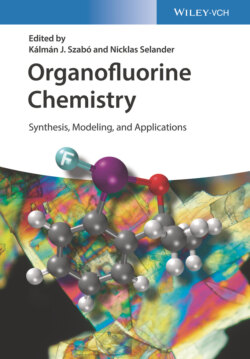Читать книгу Organofluorine Chemistry - Группа авторов - Страница 13
1.2.4 Tackling the β‐Fluoride Elimination of Trifluoromethoxide Anion via a Fluoride Ion‐Mediated Process
ОглавлениеThe trifluoromethoxy (CF3O) group is increasingly important in drug development. Although methanol is definitely stable at room temperature, its perfluorinated analog, CF3OH, is unstable at room temperature and decomposes (eliminating HF to form COF2) even at −20 °C [25]. Therefore, trifluoromethoxylation with CF3OH is impractical and the development of new trifluoromethoxylation reagents is highly desired. In 2018, we developed trifluoromethyl benzoate (TFBz) as a new type of shelf‐stable trifluoromethoxylation reagent [10]. TFBz can be readily prepared from triphosgene, KF, and PhCOBr, with COF2 being an in situ‐generated key intermediate (Scheme 1.9a). Notably, all the fluorine atoms in TFBz come from the cheap fluoride source KF. A variety of other perfluoroalkoxylation reagents can be obtained in a similar manner (Scheme 1.9b). The versatility of TFBz as a trifluoromethoxylation reagent was demonstrated by trifluoromethoxylation‐halogenation of arynes, nucleophilic substitution of alkyl(pseudo)halides, cross‐coupling with aryl stannanes, and asymmetric difunctionalization of alkenes (Scheme 1.9c).
